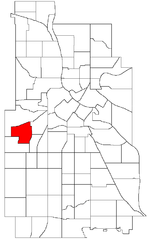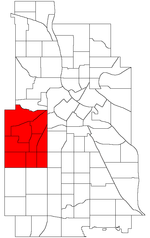Lake of the Isles
Lakes of MinneapolisParks in MinneapolisShared-use paths in Minneapolis

Lake of the Isles (Dakota: Wíta Tópa, "Four Islands") is a lake in Minneapolis, Minnesota, connected to Cedar Lake and Bde Maka Ska. The lake is part of the city's Chain of Lakes and has an area of 109 acres (0.4 km2), 2.86 miles (4.6 km) of shoreline with a little under three miles of paved walking and biking paths, and a maximum depth of 31 feet (9 m). Lake of the Isles is known for its two wooded islands, its long north arm, and the surrounding stately houses of the Kenwood, Lowry Hill, and East Isles neighborhoods.
Excerpt from the Wikipedia article Lake of the Isles (License: CC BY-SA 3.0, Authors, Images).Lake of the Isles
Lake of the Isles Bike Trail, Minneapolis Bde Maka Ska - Isles
Geographical coordinates (GPS) Address Nearby Places Show on map
Geographical coordinates (GPS)
| Latitude | Longitude |
|---|---|
| N 44.954722222222 ° | E -93.3075 ° |
Address
Raspberry Island
Lake of the Isles Bike Trail
55408 Minneapolis, Bde Maka Ska - Isles
Minnesota, United States
Open on Google Maps








